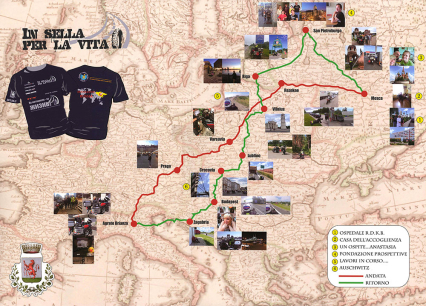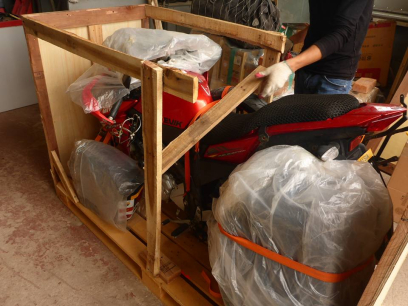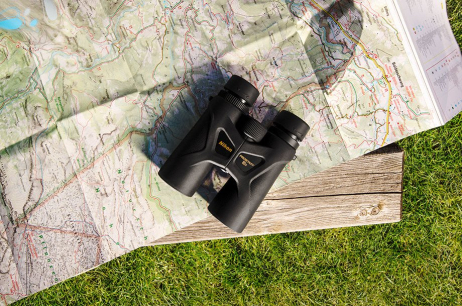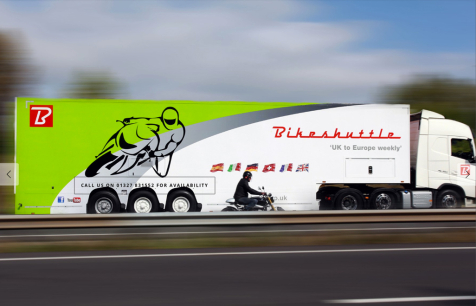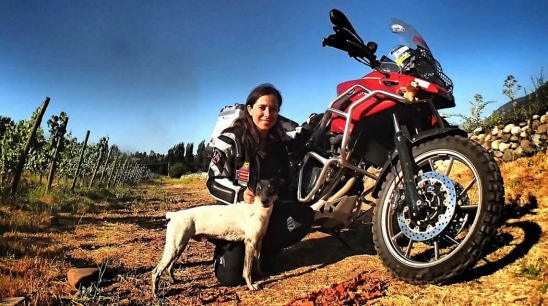Luciano is a veteran of travelling solo, a trait he shares with many of our visitors… but his age sets him apart.
Last year, 71-year-old Luciano made his way from Padua to Vladivostok. And he has no intention of swapping the seat of his bike for a comfy couch at home.
“I still have so much to explore on my motorcycle!” he exclaimed when we met him. We were left in no doubt about his boundless appetite for adventure.
Luciano, born in 1948, is from Veneto. When he is not travelling, he lives in Rovolon, a village in the Province of Padua. The first we heard of him was at the 2016 Motor Bike Expo, on an A4 sheet of white paper taped to a pillar at one of the show’s stands.
The note bore the following message in marker: “Wanted: travel partner for a Padua – Beijing ride”. It was accompanied by a mobile number.
The appeal deserved further investigation, but unfortunately we didn’t follow it up in time. Only recently did we learn that Luciano, having failed to find a reliable partner, decided last year to jump through the bureaucratic hoops, load up his motorcycle, and set off… alone, as he had done on several previous occasions.
Such decisions are usually made in your 30s or 40s, possibly when you’re a little older, but most likely not alone. Yet, it seems that Luciano had no doubts whatsoever at the prospect of not only tackling a journey which would be gruelling even for a young person, but doing so in the seat of a trusty yet time-worn 1983 Moto Guzzi SP1000.
How did it go? Perfectly! Our intrepid traveller returned home safe and sound, ready to turn the page… of his world atlas, that is.
We met and interviewed him at the 2020 Motor Bike Expo.
Here’s what he told us about his life in motorcycling.
Luciano, when did you sit in the seat of a bike for the first time?
“I had just turned 8 years old. I remember the moment well. It was 1956, and I was with my father at a motorcycle rally organised by Bianchi. At these events, it was traditional to give a riding demo involving the youngest and oldest participants. I was the youngest one there. They put me in the seat of a 125 cc Bianchina and, at the end, gave me a trophy cup that was even taller than I was.”
You really were very young. What mark did the experience leave on you?
“Well, the desire to have a motorcycle of my very own to travel around the world with.
But I had to wait until 1968, when my friend Franco and I, on a pair of Moto Guzzi Lodola GT 235 bikes, travelled 4,600 km starting from Rovolon, visiting Switzerland, France, Belgium, Luxembourg, Holland, Germany and Austria before the return trip.
The next year, we took the same motorcycles on a more arduous journey — for those times — bringing us to Yugoslavia, Hungary and Romania… all the way to the Black Sea. Almost 6,000 km.
This second journey made me realise that, if I wanted to go even further, I would have to look for a stronger and more powerful “steed”. I stayed loyal to the Moto Guzzi brand, choosing a V7 700, the first to be sold in Padua. I replaced it in 1983 with an SP 1000, the flagship model of the company from Mandello.”
When did you venture beyond the borders of Europe?
“I tried and tried for many years to get a visa to enter the Soviet Union on a motorcycle, but never got anywhere because of the travel restrictions and all the red tape.
It wasn’t until 1992, when my determination was combined with the political changes we are all familiar with, that I managed to get my hands on two visas. Would I really be able to travel within the “Russian continent” how and where I wanted? It was time to find out! I set out from Padua with my friend Luca and found myself in Moscow three days later, before going on to see Saint Petersburg, Estonia, Latvia and Lithuania. 10,000 km in about twenty days. You could say that we were taking it fairly easy that time.
One thing that I enjoy remembering about Moscow is the day that I spent in prison for insisting on taking photos in the Red Square.”
If we remember correctly, your life took a different direction after that journey, right?
“Absolutely! It was followed by an extremely long break due to an unexpected work development which then became a great passion. I inherited a small vineyard in the area of the Euganean Hills, and found the idea of becoming a wine producer so exciting that I put my desire to travel on hold for over twenty years.”
So how did you rediscover your first love?
“Every year, I promised myself I would get back in the saddle for some epic challenge.
In 2010, my motorcycle fell victim to a flood. That was the first sign. I restored it so that it was like new. That’s when I was bitten by the bug again, though it took me another 3 years to decide to close the business and get back on the road.
In 2014, I decided the time had come. I shipped the Guzzi to New York and, from there, I crossed the American Continent all the way to San Francisco, covering much of the legendary Route 66.”
When did Beijing become your target?
“In 2016. I had already begun to enjoy solo journeys, but decided to look for a travel partner anyway, particularly given my age. As you already know, I even tried giving out leaflets saying “travel partner wanted…” etc. at the Verona Expo, and to my great astonishment I actually found one. That choice turned out to be a mistake, however. Two months before our departure they pulled out, leaving me to fall into a state of deep depression. I got over it with the help of my family, who practically insisted on my taking a motorcycle journey.
I made it to the North Cape alone, a total of 10,500 km. I clocked up another 11,000 km two years later, in 2018, crossing Morocco, Spain, Portugal and France. The idea of travelling across Asia was stuck in my head like an obsession. I just had to do it.
In 2019, I decided to make the dream I had long kept tucked away come true, though, in the meantime, I had changed my destination to Vladivostok, in Siberia. I set out once more from Padua to reach that city, passing through Kiev, Moscow, Novosibirsk and Irkutsk, dipping into Mongolia as far as its capital, Ulaanbaatar, then back to Chita and Khabarovsk, crossing all of Siberia and following the Trans-Siberian Railway for 14,500 km.
My travel partner on this solo journey was once again the very same 1983 Moto Guzzi SP 1000.”
Can you tell us a few anecdotes from your journey?
“Oh, all sorts of things happened to me. I could tell anecdotes for hours.
Once, I was in East Siberia when I was unexpectedly called by the RAI 1 radio channel for a live interview on their late-night programme “Tra Poco In Edicola” [Tomorrow’s Headlines], hosted by Stefano Misurati. For a moment, I thought it was a joke: RAI interested in me? But it really was true. I was asked to get to somewhere with a good internet signal for a live interview on the following day from 12:30-01:00 a.m. local time, which was + 7 hours in Russia.
I arranged to stop off in Chita, a lovely city of about 350,000 inhabitants, with plenty of reliable services. They called me back right on time, and I can’t deny that making a live radio broadcast over 10,000 km from home was an emotional experience.
My first misfortune befell me just 3 days after I set out. I reached Russian customs during a tremendous downpour. They had me park under a low canopy of sheet metal, which was so noisy that I felt like I was on the front line, taking fire from machine guns. A policeman took my documents and gave me 4 sheets to fill out in minute detail (the certificate to temporarily export the motorcycle). I pointed out that it was written in Russian and he replied that there were no more bilingual (Russian-English) sheets.
Despite my best efforts, after four attempts which ended in failure I decided to ask the customs officer for help. He gave me a stern look, took my mobile phone, and tried to fill out the form with me with the help of Google Translate. This went on for a full 4 hours! At the end, he gave me the pile of documents and said goodbye. I headed back to the motorcycle, put everything away, and realised I had left my mobile phone in the office. No more than 5 minutes had passed. I went back and headed straight for the part of the desk where I had been sitting… but my smartphone wasn’t there. I looked the customs officer in the eye and said “sorry my phone…” in English. In a puzzled tone he replied “nema phone…nema phone….”.
Why, we had been using it together just a few minutes before! I pressed him again with my voice raised, but there was nothing to do, the phone was gone. I threatened to call the police, but he made it clear that he was the police.
There was nothing I could do but leave, slamming the door and trying to calm down. I left customs at 05:00 p.m., with the rain still bucketing down, and put the problem on hold. I had to find a place to sleep. Unfortunately, the area seemed completely deserted, with no signs of life. All I could see was countryside, rain and fog. Without the help of my smartphone, I had no idea where to go. Eventually, in order to stop one of the cars or vans that were passing, I parked the motorcycle in the middle of the street.
A car slowed down and when the old man driving it heard me shout “Pozhalusta hotel… hotel”, he indicated that I should keep going for 7 km then turn right, explaining that I would find something there. His directions were good, and led me to a large park with ten or so rustic wooden chalets built along the shore of a small lake. I rented one of these once I had made it down the access road, which was about 200 metres long and completely flooded, with water reaching my knees. I was shivering, and probably had a touch of fever. But getting back to the phone… at 05:00 a.m. the next morning, I got back in the saddle to travel down the still-flooded access road, in bare feet so that I wouldn’t get water in my boots, before heading in the direction of MOSCOW. I needed a new smartphone. In the city, I visited no fewer than five shops before finding a specialised one that could recover my contacts, get the internet working, etc. The whole process took almost six hours. When I set off again I was exhausted, but glad to have the problem resolved. I had a new SIM card, with a Russian number, but WhatsApp and Facebook worked for me. As far as Lake Baikal, the network signal was always good, meaning that I could stay in touch with my family and closest friends.”
We have to ask you how it went from a physical point of view…
“We are all surrounded by people who are ever-ready to give sage advice. Like, are you really sure you can do it? It is Siberia after all. What if something happens to you? You’re no spring chicken any more…
OK, it’s fair to bring up any potential complications… but there’s no need to make it a constant refrain. Luckily, my legendary stubbornness won the day. There was a voice inside me that begged me not to give up, to stay strong and fulfil the promise I had made to myself!
Fifty years of experience in motorcycling, with 56 countries visited and over 300,000 km crossed provided me with reassurance, telling me that I would be suddenly re-energised once again when I felt the rumble of my beloved engine. And that’s exactly what happened. The more road I covered, the better I felt, so that my whole body was in tune with my brain, transmitting strength and enjoyment. I completed 700 km and reached Budapest almost without realising it.
From the very start, I felt my physical and mental fitness increase, triggering the flow of adrenaline that transforms fatigue into pleasure, sustaining me for the entire outbound journey. I gained so much strength that I was able to face the return journey with calm too.”
What goals do you have for the future? I don’t think you intend to hang up your motorcycle helmet for good, do you?
“In 2014, when I decided to start travelling again, I had the idea of linking my tours to a charity project that I called “In Moto Per La Vita” [Riding for Life].
My main aim was to raise funds for the Premature Infants Ward of the Neonatal Intensive Care Unit in Padua’s Paediatric hospital.
So far, I have raised over €25,000 for the “Fondazione Salus Pueri”, a charitable foundation in Padua. This went towards providing a Parents’ Room featuring special “Kangaroo Chairs”, where a mother can recline holding her newborn to her chest, transmitting body heat and allowing the baby to hear her heartbeat, factors which are vital for the survival of a premature infant.”
Is there a new trip in the pipeline? Another solo journey?
“Given that I feel healthy, there’s no reason to stop. I’m thinking of doing something really special, perhaps to celebrate reaching 75! I’m kicking an idea around in my head that would lead me to India, through Turkey, Iran and Pakistan. This time I might set a more relaxed pace, considering the young age I’m approaching.
It’s important to be realistic, though. Three years is quite a while to wait for such a challenging ride. It’s better not to waste time. In fact, if it wasn’t for the Coronavirus, I would have planned it for this year. I’ll keep my fingers crossed for the next opportunity.”
A long solo journey requires both physical and spiritual preparation.
What’s the best advice you could give to a motorcyclist over 70 who wants to try it?
“It’s difficult to give advice to a motorcyclist of my own age. It’s easy to think about trying it, but what you need is to be certain that you can do it. Then it depends on the type of trip. Riding the “easy” roads of Europe is very different from tackling a genuine adventure.
So much is unforeseeable, and sometimes there can be serious obstacles. You’ve got to have nerves of steel. If you start to panic, you’re in hot water. In any case, the saying “where there’s a will, there’s a way” always applies for a true motorcyclist. The advice I would give is to thoroughly evaluate your limits based on your experiences as a motorcyclist and a traveller.
If you’re not used to travelling alone, it’s better to have company. And you also need a good knowledge of English, a suitable motorcycle, and the ability to persuade yourself that…
Everything’s going to be OK!”

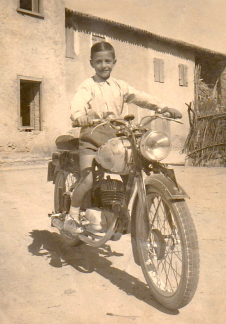
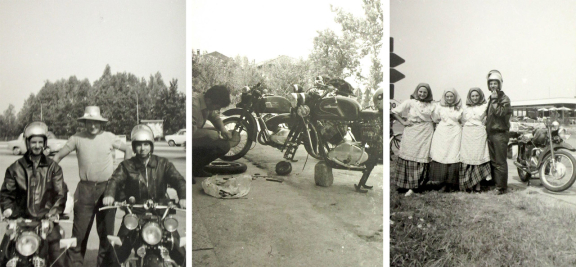

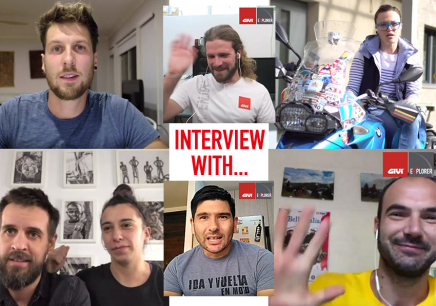
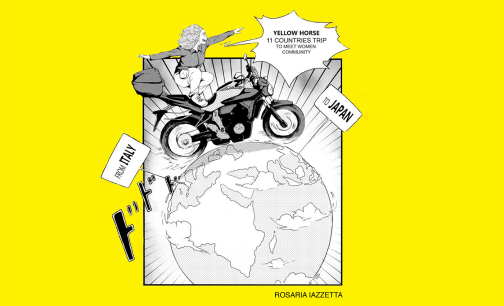
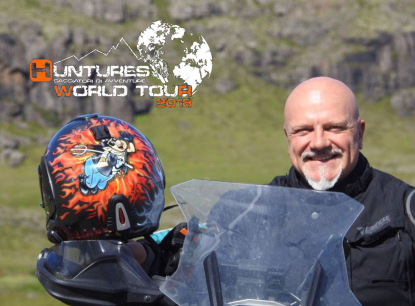
.jpg)
